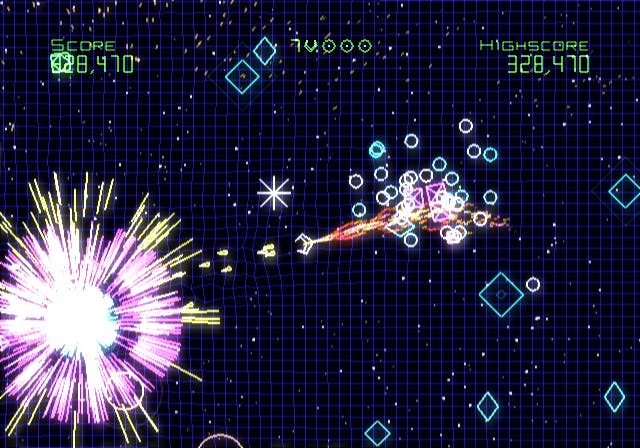Geometry Wars: Galaxies
Universal excitement.
Everybody already knows Geometry Wars: Retro Evolved is brilliant. It's all wireframe, neon, mad fuzzy, whizzy stuff that's looks beautiful. It's insanely and increasingly intense, and everybody knows it's brilliant. So how do you make it better? After it originally appeared within Project Gotham and become an instant classic on Xbox Live Arcade, where can Bizarre Creations take it next? Well actually they're not taking it anywhere. Someone else is. Vivendi Games and Kuju Entertainment are. They're taking it to the Nintendo Wii and DS, creating a sequel of sorts called Geometry Wars: Galaxies.
They're developing it under licence from Bizarre Creations, because the chaps at Bizarre are busy doing other stuff, but the original idea, and demo, was created by Bizarre. The two versions of Galaxies are now being put together by a team of about 12 people - compared to the lone coder (Steve Cakebread) who devised the original - but obviously it's very much a co-operative project with Bizarre, as Roger Carpenter, senior producer at Sierra Entertainment, confirms.
"There was a lot of backwards and forwards between Kuju and Bizarre to make sure everybody was happy with how it was going to work," he says. "But from the initial ideas from Bizarre, it has become very much a Kuju and Bizarre (and Sierra) product. They're down every couple of weeks and I talk to the guys up there daily about new bits and pieces, and they see all the latest bits of code that are here. There are ideas they come up with that work really well, and the Kuju guys come up with some really cool ideas as well." Naturally he's reluctant to reveal all of those ideas: "This is at a very early stage so there will be information that we won't divulge."

Nevertheless, the core of the game remains the same: survive as long as possible, score as many points as possible, get as high up on the leaderboards as possible. The ship still resembles the claw from Tempest, and the action still resembles Asteroids with more than a dash of Robotron. Weapons upgrade, enemies respawn, scores multiply, and the action gets more and more frantic. It's easy to understand, and it's easy to get ensnared by its one-more-go appeal.
"There are sacrosanct things in Geometry Wars," explains Carpenter. "There's the ship; there's the way it shoots; the style, the look and the feel. Everything in Galaxies is consistent with Geometry Wars, but with new life breathed into it." Indeed. Galaxies keeps all of the 'sacrosanct' features intact - the blue diamonds, the red claws, the white snakes, the weapons change every 10,000 points and so on - and it will even feature a full version of the original Retro Evolved as part of the game. And it looks the part. It looks beautiful. Crisp, glowing, luminous, scintillating. On both the Wii and the DS. "Whatever you see on there," he says, pointing to the Wii screen, "will be on here as well," he concludes, pointing to the DS. And, to judge by what's showing on each screen, he seems to be right.

But if all the team at Kuju was doing was more of the same, but on a couple of different platforms, you might start to worry about diminishing returns. So the game is not just more of the same. It's more of the same, but different. The main difference is that the game is now divided across several - and the clue is in the title - galaxies. Each galaxy is, naturally, home to several solar systems and planets, and a nifty galaxy-shaped menu allows you to zoom into each solar system, and then into each planet. Each different planet will provide a new twist on the classic Geometry Wars formula. Each planet contains a single 'battle', which replaces the infinite high-score challenge that formed the basis of Retro Evolved - although if you want to play any battle for as long as you can survive, then you can do that too. But each battle will play out against a different set of constraints - a different type of playing grid, for example, or a different set of objectives. Among the different battles that Carpenter was prepared to show off were a classic Retro Evolved-style encounter; a classic Retro Evolved-style encounter but on a smaller grid; and an encounter that played out on a hexagonal grid with a gravity well in the middle of it - a bit like Space Wars.

.png?width=291&height=164&fit=crop&quality=80&format=jpg&auto=webp)




.jpg?width=291&height=164&fit=crop&quality=80&format=jpg&auto=webp)
